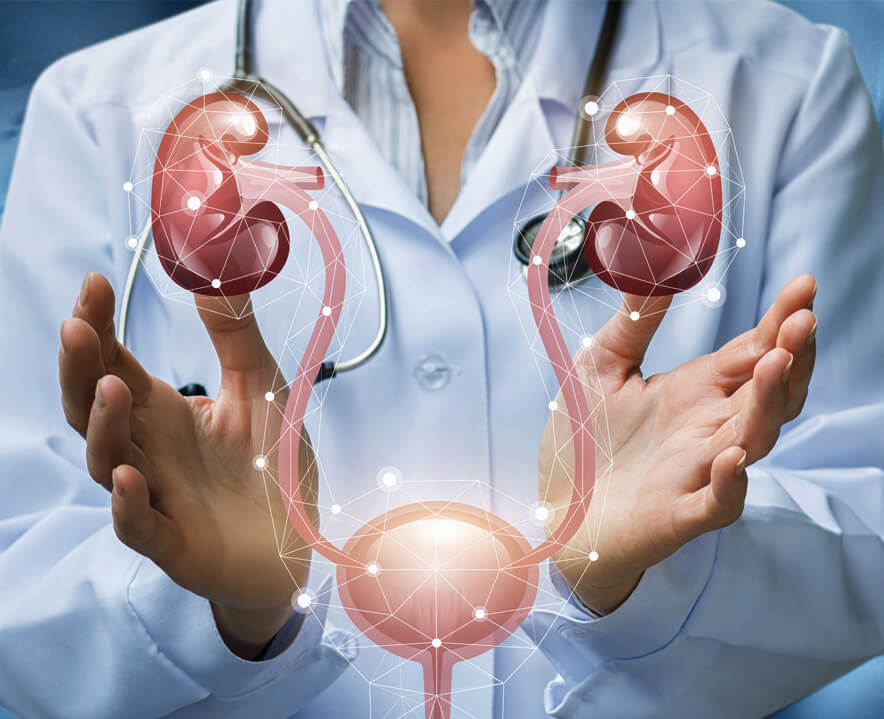Conditions Treated by Reconstructive Urology in Bangalore
Reconstructive urology addresses a range of conditions that affect the urinary tract and reproductive organs. Some of the most common conditions we treat include:
-
Urethral Stricture: A narrowing of the urethra often treated with BMG Urethroplasty. This procedure restores normal urine flow and eliminates the discomfort caused by urethral strictures. Learn more about BMG Urethroplasty
-
Erectile Dysfunction: Erectile dysfunction is a common condition that affects a man's ability to achieve or maintain an erection, impacting overall quality of life.
-
Bladder Fistulas: Abnormal openings between the bladder and nearby organs, such as the rectum or vagina.
-
Pelvic Floor Disorders: Including urinary incontinence, fecal incontinence, and pelvic organ prolapse.
-
Peyronie's Disease: Fibrous scar tissue forming on the penis, causing painful erections.
-
Traumatic Injuries: Injuries to the kidneys, bladder, penis, or testicles.
-
Neurological Conditions: Disorders like Parkinson's disease or multiple sclerosis affecting urinary and reproductive functions.
Reconstructive Urology Treatments at Blue Bliss Hospital
At Blue Bliss Hospital, we specialize in providing comprehensive reconstructive urology treatments for patients in Bangalore. Our treatments aim to restore the normal functioning of the urinary tract and reproductive organs through the use of advanced surgical techniques.
Advanced Urological Procedures:
-
Urethral Reconstruction: We use BMG Urethroplasty and other advanced procedures to treat urethral strictures, restoring normal urine flow and function.
-
Bladder Augmentation: For patients with neurological conditions or bladder cancer, we perform bladder augmentation using continent urinary diversion or intestinal conduit diversion.
-
Fistula Repair: We perform surgery to repair fistulas, closing abnormal openings between the bladder and other organs.
-
Penile Surgery: We treat hypospadias and other congenital conditions, restoring normal function and appearance.
-
Pelvic Organ Surgery: Our team treats pelvic floor disorders like urinary incontinence and pelvic organ prolapse using both surgical and non-surgical approaches.
-
Trauma and Injury Repair: We repair injuries to the kidneys, penis, bladder, and testicles, restoring function and improving quality of life.
-
Laparoscopic and Robotic-Assisted Surgery: We use minimally invasive techniques like laparoscopy and robotic-assisted laparoscopy to perform ureter and bladder reconstruction, reducing recovery time and hospital stay.
Why Choose Blue Bliss Hospital for Reconstructive Urology in Bangalore?
At Blue Bliss Hospital, we are recognized for our expertise in reconstructive urology. Here's why we are the best choice for urethral stricture treatment, pelvic floor disorders, and other complex urological conditions:
-
Expert Reconstructive Urology Doctors in Bangalore
Our team of expert urologists is led by Dr. L.N. Raju, one of the best reconstructive urology doctors in Bangalore. With over 20 years of experience, Dr. Raju specializes in BMG Urethroplasty and other advanced urological procedures, ensuring high success rates for all treatments.
-
State-of-the-Art Facilities
Our hospital is equipped with the latest medical technologies and minimally invasive surgical tools to perform highly effective reconstructive urology treatments with minimal discomfort and faster recovery times.
-
Personalized Treatment Plans
At Blue Bliss Hospital, we focus on creating personalized treatment plans for each patient. Whether it's urethral stricture surgery, bladder augmentation, or pelvic organ repair, we ensure that our treatments are customized to achieve the best possible outcomes.
Cost of Reconstructive Urology Treatment in Bangalore
The cost of reconstructive urology treatment in Bangalore depends on the complexity of the procedure and the individual needs of the patient. However, at Blue Bliss Hospital, we aim to provide cost-effective solutions without compromising on quality.
Estimated Cost for Common Procedures:
| Procedure |
Estimated Cost (INR) |
Description |
| BMG Urethroplasty |
₹1,22,000 – ₹1,90,000 |
Surgical reconstruction using buccal mucosa graft for urethral stricture treatment. |
| Urethral Stricture Dilation |
₹26,000 – ₹39,000 |
Non-surgical method to widen the narrowed urethra. |
| Bladder Augmentation |
₹80,000 – ₹1,50,000 |
For patients with neurological diseases or bladder cancer. |
| Penile Surgery |
₹45,000 – ₹70,000 |
Surgery for conditions like hypospadias or penile trauma. |
Please note that these figures are for reference purposes only, and the actual prices may vary.
Flexible Payment Options:
We accept a variety of insurance plans and offer EMI options to make reconstructive urology treatments more affordable.
Schedule a Consultation for Reconstructive Urology Treatment in Bangalore
If you're experiencing symptoms like urinary incontinence, urethral stricture, or pelvic organ prolapse, Blue Bliss Hospital offers expert care through advanced reconstructive urology treatments. Contact us today to schedule a consultation with Dr. L.N. Raju.
